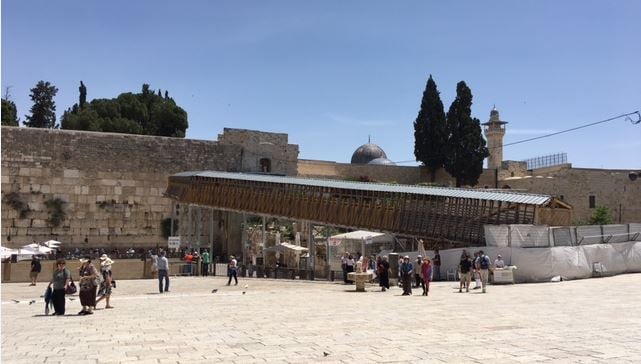The annual three-week mourning period for the destruction of the Holy Temples, marking the days from when the walls of Jerusalem were breached until the Temples were destroyed – which this year falls July 24-August 14 – is an especially appropriate time to deepen our learning and to visit places connected to the Beit HaMikdash (Holy Temple). Tel Shilo, the Temple Institute, and of course the Temple Mount itself, are all relevant destinations.
To walk through Tel Shilo (ancient Shilo), the site where the Mishkan (the Tabernacle) stood for 369 years, is to walk into the pages of the Bible. There is a beautiful visitor center and picnic area, and one can take a fascinating walk through ancient Shilo homes and buildings towards a newly built lookout tower. Along the way is the place where Eli, the Kohen Gadol (high priest), who was waiting by the road at the entrance to the city, fell off his chair, broke his neck and died upon hearing that the people had been defeated, his two sons had been killed and the Ark of the Covenant had been stolen by the Philistines (1 Samuel 4). The area is covered in almond trees, which is a reminder of the Menorah (candelabra) in the Mishkan that was “engraved like almonds.” (Exodus 25:33)
At the lookout tower one could see a wonderful movie that brings together many biblical sources about Shilo and integrates the archaeology seen behind it with the video. In other words, while sitting in the tower, a visitor will have an incredible view of the original walls of the Mishkan! According to Jewish tradition, the Mishkan in Shilo had permanent walls, but a tent-like roof. We can see from the Biblical references that it was both a “house” (1 Samuel 1:24) and a tent, or “tabernacle” (Psalms 78:60), and therefore had walls like a house but a roof like a tent. It is remarkable to have found the outline of the stone walls thousands of years later.
You will see the place where Hanna prayed for a son (1 Samuel 1), and where her son Shmuel (Samuel) was brought as a child to serve in the Mishkan. Above the archaeological site, is the modern town of Shilo. Its synagogue has incorporated many of the Temple vessels into its design. Tel Shilo has some special events in the summer connected to the days of mourning, and also a women’s dance event connected to an ancient ritual on the 15th of the Hebrew month of Av. They also offer ATV rides for those who want an adventure experience in the land of Israel. For more information, see their website.
‘Feel Electricity in Your Soul’
The Temple Institute, in its relatively new location in the Jewish Quarter of the Old City of Jerusalem since 2014, has become a must-see site. In 1967, during the Six-Day War, Rav Yisrael Ariel was an Israeli soldier who found himself stationed on the Temple Mount. He explains that when you stand in such a holy place, you feel electricity in your soul. Like many, he was surprised that the Israeli government gave the control of the Temple Mount, Judaism holiest place, over to the Jordanian Waqf (Muslim religious authority) following the war. He decided that the Jewish people and the world in general need to learn more about the Holy Temple, because this puzzling decision of the Israeli government seemed to reflect a lack of understanding. Rav Ariel founded the Temple Institute in order to study all the Jewish sources connected to the vessels of the Temple, and eventually starting recreating most of them. The Temple Institute is set up like the Holy Temple itself.
The first room in the “Temple Mount” room shows the history of the Temple Mount and the Holy Temples through beautiful artwork and a fabulous model of the Temple itself. The experience of the second room is like walking inside the courtyard and seeing the Kohanim (priests) who served in the Temple in their special garments. There is a mizbe’ach (altar) as well as displays about the special dyes used for their clothes and other fabrics in the Temple. The process of recreating these holy vessels has been a process of reviving the knowledge and arts involved in making and using them.
Entering the third room is like walking into the Heichal (the sanctuary – the enclosed building itself). Most of the vessels made by the Temple Institute are fitting for use in the Holy Temple, such as the incense altar and showbread table that are displayed in this room. The Ark of the Covenant, however, is just a model and could not be used in the Temple. Why not recreate the Ark of the Covenant? First, mainstream Jewish thinking is that it is waiting for us in the Temple Mount, where it was hidden in the First Temple Period in tunnels dug by King Solomon for this purpose. Second, we cannot recreate the most important part, the items that according to Jewish tradition were hidden away during the First Temple Period in the time of King Josiah for safekeeping: the Tablets of the Ten Commandments, the broken Tablets, the Torah scroll that Moses wrote, a jar of manna and Aaron’s rod.
A visit to the Temple Mount itself is a holy experience and should be treated as such. Once Shiloh was destroyed, its holiness was lost. However, the Divine Presence has been eternally connected to Mount Moriah/the Temple Mount since the time the Temple was built there.
There are different opinions about visiting the Temple Mount within the Jewish world, and advice from a knowledgeable authority should be sought by Jews or non-Jews wanting to visit. It’s important to understand how to prepare, where to walk, what to wear, etc. In addition, the State of Israel has many regulations in coordination with the Muslim authorities on the Temple Mount which must be followed. If you are near the Western Wall, you will notice a special entrance to the Temple Mount that displays opening hours, and there is a place to line up to go through security. Once passing through security, visitors ascend a wooden and metal bridge that leads to a gate. This gate is commonly known as the Mugrabi Gate, but was recently renamed the Hallel Gate (Gate of Praise) in memory of Hallel Yaffa Ariel, a 13-year-old girl, who was brutally murdered in her sleep in Kiryat Arba, a suburb of Hebron. Whether you go up to the Temple Mount or not, you can look upwards and see the newly renamed Hallel Gate – and remember the Holy Temple and those who have given so much for the return of the Jewish people to the Land of Israel and all of the places of our Biblical heritage.
By: Leah Bowman
(The author, a licensed tour guide, leads inspiring tours throughout Israel, including child-friendly and bible tours. Check out her website and blog page.)

Free Ebook: 10 Best Places to Visit in Israel
The Land of Israel has provided the backdrop for some of the most important events in human history. From the Old City in Jerusalem to the Sea of Galilee, people from all over the globe visit the Holy Land each year to take in the breathtaking scenery and inspiration of Israel. Now you can experience this beauty for yourself from the comforts of home and maybe plan a trip of your own to Israel. Get the free, exclusive eBook from United with Israel: The 10 Best Places to Visit in Israel.
